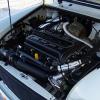The gearbox was sent to me to sort out an issue with it locking on the baulkrings ( you may find the thread in the technical section somewhere ), while stripping it I noticed that the diff was rather tight ( well in fact.. If I'd welded the sod together it would have had more movement). After informing the owner, they said they'd had a real problem putting the unit together and actually returned it to Minispeed for them to build and return, which they duly did, and was put into the gearbox as supplied.
Initially I suspected that the Mica thrusts were too thick, this is not uncommon as there are some 'oversized' mica's on the market. These are useful on 'loose' differentials and take up the wear in pinion gears and the differential assembly and are 0.043" thick rather than the standard 0.035". Both sizes are available from Minispares under part numbers BTA101(std) and BTA102(0.043").
So I stripped the diff down only to find two rather old used items, which one would say is a little odd, and usually points to a tolerance issue, so I partially rebuilt the diff with the output shaft, 4 pinions, the 4 bronze thrusts but no mica just so I could measure the endfloat between the output shaft and the diff. I did this with a DTI on the end of the output shaft, lifting it from rest on the pinions to contact with the diff cage.. This turned out to be just shy of 0.029" which is considerably below the standard thrust thickness, but not the end of the world...
A not insignificant time later I had sanded down a mica thrust to 0.029" ready to test fit... which I did, and everything seemed to be in order... OK a little 'notchie' for my liking but at least I could turn the output shaft...
Next was to build the diff for real, so removed the pins and placed the square(ish) centre block into the diff... well I say placed, in fact it just would not fit.. Again you would surmise that this is due to an overly thick Mica thrust moving the output shaft further in than it should be, and thus moving the pinions inward, but I knew this was not the case with only a 0.029" mica in there and there was NOWAY I was removing any more off that or first turn of the diff and it would have rolled up like a piece of paper. So next alternative was the pinions themselves.
Although new, they were not genuine, so I replace with 4 genuine rover pinions to see if that made any difference... which to be honest it didn't so there was nothing wrong with the pinions.. The only alternative was to try 4 decent used pinions which obviously over time have had the teeth smoothed and shaped by wear. This did afford a little more play and with a little bit of jiggling was able to insert the square block into the middle of the diff, but by-eck it were tight.. But, inserting the pins was not easy, and after a good look, the holes in the block didn't line up exactly with the holes in the diff cage or pinions. A little persuasion was necessary to tap the pins in, but once again, the diff was locked solid..
Lets just say my language at this point was getting a little
So I pulled it apart again, and tried every possible orientation of this center block to get it to fit.. No such luck... so I decided on the 'least tight' orientation and marked the block up with a pen so I could fit it the same way again... and removed...
It was evident that the fit was tight, not only from fitting, but you could see nice little score and press marks in the steel where the pinions had located themselves... so I linished the faces flat and test fitted again... still locked.. but I now had nice fresh imprints of where the pinions were binding..
A couple of goes with the wet&dry later and still no joy..
So the big file came out if the tool box... this is extreme measures, a light file on all four faces and a test fit, and I had 1 pinion which would actually move.. I marked that one up and had a go with the file on that single face and test fitted again... Oh the joy when one pinion would actually spin..
With that as a reference I then took the file to the block on the other 3 faces, only taking a little at a time and again a test fit... after about 3 goes and a final smooth on the wet&dry, I had a block which fitted, and all the pinions turning...
At this point I would remind you that these are USED pinions, I tried to refit the block with the new pinions and there was not a cat in hells chance of it fitting so as I don't have a milling machine in the garage the used were replaced back into the diff and it was built.
Horrah, a Minispeed diff which actually spins...
Oh but the story does not end... to complete the diff you need a second output shaft and a crownwheel.
Same again, put a new std mica on the output shaft, placed onto the diff unit and proceeded to bolt up the Crownwheel to hand tight, and yes would you believe it, locked solid again...
So same as I did with the other output shaft, I removed the mica, refitted the output shaft and crown wheel and measured the end float.. 0.029" ( well at least there's some consistency ! )
So back out with the sand paper and another mica thrust...
Finally I had a diff which I would be prepared to actually put into a gearbox.. but FIVE flippin' hours, if I were to charge for that the labour would have been more than the cost of the diff itself.
So in summary....
This diff has been built with 4 used pinion gears, 2 'skinny' mica thrusts (80% the thickness they should be) and the centre support block required modification to even allow the fitment of undersized parts.
Building the diff as supplied, in my opinion, was impossible, and for what should be a precision machined piece of equipment the quality of fit is shocking to say the least.
Here's a pic of the finshed (working) unit...
 23042008020.jpg 603.19K
212 downloads
23042008020.jpg 603.19K
212 downloadsOne thing I would also like to say about the unit is the pins, I'm not overly happy about how they sit in the unit, they are VERY deep set and also I'm not overly confident of the material used, and I have my suspicions that that are not hardened or Moly' coated, however I cannot confirm that statement.
A recommendation..
If you want an x-pin that will fit 'out of the box', then go to Minispares, Min-its, MRA-Minis or even myself, I am 100% confident of the quality and fit of these supplied units, and if purchasing from me and you want to send me your old diff I'll build if for you for nothing, as I know it'll only take me 15 minutes tops.

















